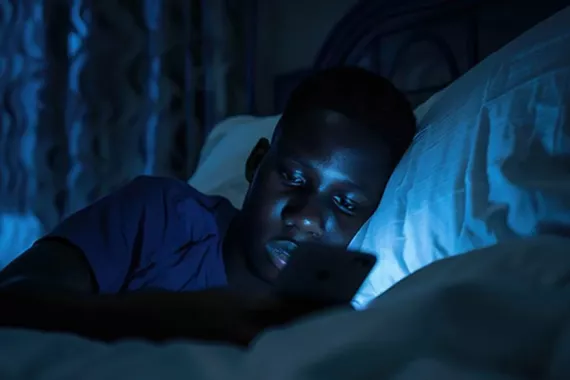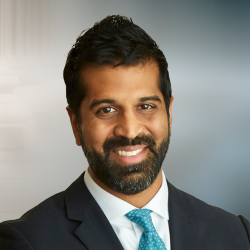
The Legal Team
- Andrew P. Arnold
- Esther E. Berezofsky
- Ebony Williams Bobbitt
- Riley Breakell
- Abigail Burman
- Jessica L. Carroll
- Grace P. Chandler
- Jessica C. Colombo
- Sara O. Couch
- Nelson L. Drake
- Jodi Westbrook Flowers
- Jade A. Haileselassie
- Mathew P. Jasinski
- Marlon E. Kimpson
- Annie E. Kouba
- Tope O. Leyimu
- Paul T. Lyons
- P. Graham Maiden
- Kate E. Menard
- Donald A. Migliori
- Lance Oliver
- Jonathan D. Orent
- Joseph F. Rice
- Tammy Cauley Rivers
- Previn Warren
Case Overview
Social media is heavily integrated into the daily lives of kids, but it can negatively affect their health. Research shows that social media has a detrimental impact on the sleep quality of adolescents, in particular. Learn how time spent on social media can impact teens’ sleeping habits and, in turn, play a potential role in their performance and behavior at school.
Key takeaways about social media and sleep
- Social media apps can disrupt adolescents’ sleep through push notifications, endless scrolling and fear of missing out (FOMO).
- Sleep deprivation might lead to lower grades and behavioral problems in teens.
- People are suing social media companies alleging harms they’ve experienced from their use of defectively designed, addictive social media apps.
How does social media affect sleep?
Use of social media can affect sleep duration and quality by exposing kids to blue light and creating an addictive cycle of engagement that interferes with rest. These features can lead to less sleep and poorer sleep quality among young people. Insufficient sleep can cause kids to be tired during the day and negatively affect their development and wellbeing.
Instagram, Snapchat, YouTube and TikTok all have features that encourage prolonged usage, especially before bedtime. In particular, many social media apps rely on push notifications to inspire kids to open the app when they should be sleeping. A push notification is an alert sent to users' electronic devices to make them aware of new activity on an application. These push alerts can draw kids back to the apps when they should be sleeping.
Studies show that poor sleep quality can impact physical and mental health. Sleep deprivation can lead to:
- Cardiovascular risk
- Decreased cognitive performance
- Compromised immune system
- Depression
- Future suicidal behavior
- Immune function changes
- Increased risk-taking
- Metabolism changes
- Mood changes
- Poorer school performance
- Weight fluctuations
Data also shows that sleep-deprived teens are more likely to take dangerous risks while driving, use drugs and alcohol and act violently.
Keep reading to learn more about how each social media app can affect sleep.
How Instagram allegedly affects sleep
Text, email and push notifications from Instagram may affect sleep patterns. Instagram’s app design allegedly uses these methods to send vague notifications about activity on the app. These notifications pique interest and motivate kids to open Instagram. Lawsuits allege that these notifications are especially harmful when they come through at night when the user should be winding down or sleeping.
A teenager’s developmental state makes them seek social rewards more frequently than adults. Also, adolescents often lack the impulse control to ignore the notifications. As a result, it can be easy for young adults to become addicted to social media apps like Instagram.
The flow state kids can enter while on Instagram may cause sleep problems. Entering a flow state on social media means the user is fully absorbed in the content. The flow state can often lead to spending a lot of time on the platform without interruptions.
Instagram Reels is a popular short-form video feature that grabs the attention of users and can lead to a flow state. Reels appear in a user’s feed and begin playing automatically. Reels hook the user’s attention and encourage them to begin mindlessly scrolling.
App developers refuse to add protective features
Meta Inc. — Facebook and Instagram’s parent company — could help kids break away from this flow state, but plaintiffs allege it’s chosen not to do so. Leaked internal documents show that Meta conducted research on how to reduce screen time and proposed several features but chose not to implement them.
Studies show that about one in six American teens say they use Instagram “almost constantly.” Excessive Instagram use among youth raises concerns about its negative health impacts, including sleep disturbances. As a result, many lawsuits against Instagram concentrate on the company’s responsibility for allegedly harming young people.
How TikTok allegedly affects sleep
TikTok may affect sleep because it provides a never-ending library of videos that can warp a user’s sense of time. TikTok also hides the clock at the top of some phones, making it even easier for the user to lose track of time. An estimated 63% of American teenagers have a TikTok account and open the app daily.
Social media usage is a common pre-bedtime activity for teenagers, but the time spent on apps like TikTok delaying bedtimes and leading to sleep problems.
In theory, TikTok’s Family Pairing feature allows a parent to control screen time – the type of content the child can view and set messaging preferences. But lawsuits claim that Family Pairing is extremely flawed.
Reasons the Family Pairing feature is allegedly faulty include:
- Family Pairing isn't a mandatory feature for minors.
- Family Pairing requires the parent to also sign up for TikTok.
- A parent must be aware of a child’s TikTok account.
- Kids can browse TikTok without an account.
- TikTok can be used on a web browser, but Family Pairing is only available through the downloaded app for mobile phones and tablets.
How Snapchat allegedly affects sleep
Snapchat is a social media platform where users can send photos and short videos that disappear after they’ve been viewed. It's a popular communication application among kids. Snapchat’s push notifications are designed to create urgency and encourage kids to open the application. Receiving Snapchat notifications at night can disrupt sleep and compel users to engage with the app at an inappropriate hour.
Several types of notifications that users can receive may impact sleep health.
- New Snap: Push notifications inform users every time they receive a new Snap. Push notifications are disruptive and hard to disregard. New Snap notifications can cause social pressure for teens because of their fear of missing out (FOMO).
- Snap Story: Snapchat’s Stories feature enables users to post a photo or video that expires in 24 hours. Because a story’s lifespan is limited, notifications create extra urgency among youth. Missing a friend’s story could cause anguish from FOMO.
- Streaks: A Snap Streak is an engagement metric users earn when they send or receive at least one Snap with a friend in three consecutive 24-hour periods. Snapchat sends notifications if a Streak is close to expiring. Maintaining Streaks is important to teenagers. Recent studies show that losing a Streak can cause teenagers to feel negative emotions.
Notifications make it challenging for young teens and children to ignore the app. The notifications can amplify the pressure teens already feel to maintain their friendships on Snapchat.
Snapchat’s notifications are effective. One study found that American teenagers reported checking Snapchat 30 times a day on average. Another study reported that 15% of U.S. teens use Snapchat “almost constantly.”
The distress Snapchat causes teens may lead to health issues and poor sleep habits. Many parents are taking action with Snapchat lawsuits.
How YouTube allegedly affects sleep
YouTube is allegedly designed to make kids enter a flow-like state that encourages frequent use. This state of mind makes it challenging for adolescents to self-regulate their activity time and can lead to poor sleep patterns.
The flow-inducing tactics YouTube deploys are recommended videos, an autoplay feature and YouTube Shorts.
- Recommended Videos: YouTube recommends videos for users to watch on their homepage and on each video as a suggested “next up” option. YouTube’s technology collects data about the user and uses the information to suggest videos that will hook them.
- Autoplay: The autoplay feature ensures a new video is queued up at the end of each video. The next video will automatically start playing. Since videos will continue to play without any action from the user, there's no natural stopping point. Without a natural stopping point, kids have a hard time removing themselves from the flow state.
- YouTube Shorts: Shorts compete with Instagram Reels and TikTok. Users swipe through the short-form videos to watch media tailored to their interests. The never-ending catalog of videos for kids to access makes it easy for them to lose track of time.
These three features can contribute to excessive use and disrupted sleep in adolescents. One study found that for every 15 minutes a teen watches YouTube, they're 24% more likely to experience sleep deprivation.
Data also shows that recommended videos make up 70% of a user’s time on YouTube.
YouTube is easily accessible to kids because it comes pre-installed on many tech devices and doesn't require an account. Usage among adolescents is extremely high. Reports show that more than 95% of teenagers have used YouTube and 75% of them visit it daily.
Many parents believe that YouTube and other social media sites are damaging the mental health of their children and causing sleep deprivation. These concerns are leading parents to explore legal action and file YouTube lawsuits.
How sleep impacts academic success and school behavior
Recent research shows links between sleep habits and academic performance and school behavior. Experts also believe that social media can cause sleep deprivation, which contributes to making social media apps a public nuisance.
Missing sleep adds up
The American Academy of Sleep Medicine found that children are losing nearly a night’s worth of sleep every week because of their social media habits. In some cases, kids stay up late scrolling on social media apps. Other times, they give in to FOMO by waking up at various points in the night to check their notifications. Students self-report that social media interrupts their sleep. Nearly a quarter of teenage girls surveyed in 2023 reported that using TikTok caused them to lose sleep daily.
How sleep affects grades
Research shows a correlation between social media and grades: More time spent on social media corresponds to lower grades. A 2017 study found a link between sleep and brain structure. It also correlated lower grades to later weekend bedtimes.
Some researchers believe more studies are needed to strengthen the link between grade-point average (GPA) and sleep. Many studies rely on self-reported sleep data, which isn’t as reliable as formal experiments in a controlled setting. Also, some researchers believe that more studies should look at quality of sleep, rather than focusing entirely on sleep duration.
How sleep affects classroom behavior
Studies have indicated that inconsistent sleep may increase the chances of school expulsion or suspension. Getting a consistent amount of sleep and keeping a consistent bedtime might lead to better learning and behavior. Experts believe that good “sleep hygiene” — which includes avoiding social media alerts as bedtime approaches — can lead to consistent sleep.
How schools are addressing sleep-deprived students
Researchers are examining the link between early start times and academic success. School start times vary worldwide, but countries with highly ranked education systems have some commonalities. Public schools in Finland, the second-ranked system, start at 9 a.m. Public schools in Canada, which ranks fourth, start their day at 8:30 a.m.
A study of American high schools also showed improvements in attendance and graduation rates, according to the Journal of Clinical Sleep Medicine. Researchers examined data from schools in seven states. Participating schools moved to later start times, ranging from 25 minutes to 75 minutes. Graduation rates increased 7% in the first year of the study, reaching 10% in the fourth and final year.
Sleep and social media lawsuits
Individuals and school districts are both taking legal actions against social media companies, alleging that these companies have deliberately caused harm to children’s physical and mental health. Though many of these lawsuits are filed against the same defendants, the plaintiffs often differ in the type of harms they claim to have suffered.
Individual sleep deprivation and social media litigation
Parents, guardians and adults who were harmed as children allege a wide variety of harms, including:
- Anxiety disorders
- Depressive disorders
- Disruptive, impulse-control and conduct disorders
- Eating and feeding disorders
- Obsessive-compulsive and related disorders
- Self-harm
- Sleep disorders
- Suicide
- Suicidal ideation
- Trauma- and stressor-related disorders
School district sleep deprivation and social media litigation
School districts have joined the multidistrict litigation (MDL) against social media companies. They allege that problematic use of social media, which often leads to sleep deprivation, has:
- Compromised their ability to provide mental health services and learning support
- Forced them to pay for property damage caused by students with mental health issues in connection with social media
- Harmed students’ attention spans and critical thinking skills, potentially requiring changes to teaching methods and lesson plans
Frequently asked questions about social media and sleep
How do social media habits disrupt sleep?
Social media use affects sleep because social networking apps foster addictive use, encouraging kids and teens to spend time on apps that should be spent sleeping. This leads to both less sleep overall and worse sleep quality. Sleep disturbance in teens can impact physical and mental health, including cardiovascular risk, cognitive performance, immune function and mood.
What are the side effects of using your phone at night?
Insomnia and poor sleep quality are side effects of using your phone at night. Insufficient sleep can also be correlated to:
- Cardiovascular risk
- Compromised immune function
- A decline in brain functions used for critical thinking, problem-solving, memory and more
- Depression
- Increased anxiety
- Negative effects on weight and metabolism
How does social media affect sleep deprivation?
Social media algorithms are designed to influence dopamine delivery. Elevated dopamine levels lead to compulsive social media usage and sleep deprivation. When dopamine levels decrease, kids can start feeling anxious and irritable, making it difficult for them to fall asleep. Young people who forgo sleep at night to use social media because of FOMO, or fear of missing out, may be more likely to develop or worsen a major depressive disorder.
Eligibility
Who can file a teen social media harm lawsuit? Parents or guardians can file a lawsuit against social media companies on behalf of their minor children who suffered mental health harms such as suicidal ideation, eating disorders and depression requiring hospitalization. Young adults can also file a lawsuit if they were minors when their trauma was diagnosed or treated.
Our social media lawsuit experience
If you or a loved one have experienced harm caused by social media use, our law firm can assist with a potential legal claim. Motley Rice attorneys have experience with complex lawsuits against tech companies. Contact our team today to learn more about how we can support you and your family.
How does social media affect sleep?
How sleep impacts academic success and school behavior
Sleep and social media lawsuits
Frequently asked questions about social media and sleep
Our social media lawsuit experience
- Sources
- Bloomberg. Inside the Mind of a Snapchat Streaker.
- Business Insider. How a failed education startup turned into Musical.ly, the most popular app you’ve probably never heard of.
- CNBC. YouTube’s dark side could be affecting your child’s mental health.
- Hale L, Kirschen GW, LeBourgeois MK, Gradisar M, Garrison MM, Montogmery-Downs H, et al. Youth screen media habits and sleep: sleep-friendly screen-behavior recommendations for clinicians, educators, and parents. Child and Adolescent Psychiatric Clinics of North America. 2018 Apr; 27(2): 229-245.
- Hristova D, Jovicic S, Göbl B, de Freitas S, Slunecko T. “Why did we lose our snapchat streak?”. Social media gamification and metacommunication. Computers in Human Behavior Reports. 2022 Mar;5:100172.
- Koob G, Volkow N. Neurobiology of addiction: a neurocircuitry analysis. Lancet Psychiatry. 2016 Aug; 3(8): 760-773.
- Levenson JC, Shensa A, Sidani JE, Colditz JB, Primack BA. The association between social media use and sleep disturbance among young adults. Preventive Medicine. 2016 Apr;85:36–41.
- Liu X, Buysse DJ. Sleep and youth suicidal behavior: a neglected field. Curr Opin Psychiatry. 2006 May;19(3):288–93.
- McKeever PM, Dodd R, O’Sullivan DM. Delayed high school start times and graduation and attendance rates over 4 years: the impact of race and socioeconomics. J Clin Sleep Med. 2022;18(11):2537–2543.
- Merriam-Webster. Clickbait.
- Psypost. New study links irregular sleep patterns to academic and behavioral problems in adolescents.
- The Conversation. Students could get more sleep and learn better if school started a little later.
- The New York Times. On YouTube’s Digital Playground, an Open Gate for Pedophiles.
- Pew Research Center. 6 facts about Americans and TikTok.
- Pew Research Center. Teens, Social Media and Technology 2022.
- Pillion M, Gradisar M, Bartel K, Whittall H, Kahn M. What’s “app”-ning to adolescent sleep? Links between device, app use, and sleep outcomes. Sleep Medicine. 2022 Dec;100:174–82.
- Piper Sandler. Taking Stock with Teens.
- Roberts RE, Duong HT. The prospective association between sleep deprivation and depression among adolescents. Sleep. 2014 Feb 1;37(2):239–44.
- Urrila, A. S. et al. Sleep habits, academic performance, and the adolescent brain structure. Sci. Rep. 7, 41678; doi: 10.1038/srep41678 (2017).
- Wired. On TikTok, There Is No Time.
- YouTube. Recommended Videos.
Start Your Motley Rice Consultation in Simple Steps
Submit Information
Call us or fill out our online form with the details of your potential case.
Case Review
Our team reviews your information to assess your potential case.
Case Consultation
Talk with us about next steps.



